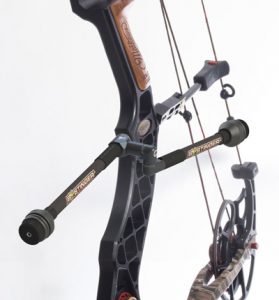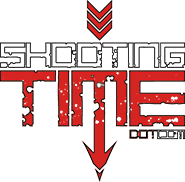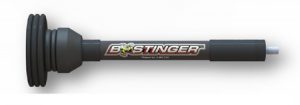 Understanding hunting stabilizers can be complicated but the principles of stabilization are always the same. The longer the bars and the more weight on the end of the bars equal a high “moment of inertia” which controls the bow movement at the shot and during aim. You also need to ensure you have very rigid and durable components and brackets in the middle of the system to make sure you are getting the most out of your hunting stabilizers.
Understanding hunting stabilizers can be complicated but the principles of stabilization are always the same. The longer the bars and the more weight on the end of the bars equal a high “moment of inertia” which controls the bow movement at the shot and during aim. You also need to ensure you have very rigid and durable components and brackets in the middle of the system to make sure you are getting the most out of your hunting stabilizers.
How to setup your hunting stabilizers
If you put all the weight on one end it may not aim as good as splitting it up between two bars like the Sport Hunter Extreme setup. Hunting setups are always a balance in stabilization, portability and maneuverability.
Observe your bow
The best thing to do when you initially set up a bow is to see how the bow reacts without hunting stabilizers; it will give you a better idea on how to stabilize the bow. If the reaction is neutral, meaning it does not kick hard one way or another, then the bow needs a more neutrally balanced setup (close to equal weight on the front and back bar) or very little weight on the end of single bar. Keep in mind the longer bars will give you a softer aim.
Adjust your hunting stabilizer’s weights
If the top limb kicks back pretty hard at you, you are going to need some leverage out front to keep it reacting more neutral. That means a short bar with a lot of weight, or a longer bar with less weight. When you get the bow reacting neutrally you can now experiment with weight to get the optimal hold. This may be very unique to the individual depending on how hard you push or pull throughout the shot, how much holding weight you have, and other various form characteristics you might have. This may require more mass weight by a system like the Sport Hunter Combo that allows you to put weight front and back to increase the mass weight without changing how the bow reacts. On the Sport Hunter stabilizer you can change and add weights 1 OZ at a time so you can fine tune your setup.
 With the new Pro Hunter Maxx you get an extremely efficient stabilizer with weight adjustment every 2 oz up to 10 oz with additional weights available if you want to run more. Most shooters tend to like just a slight pull down from the stabilizer as a static starting point. These stabilizers are very popular in Bowhunter Class competition where the shooters are limited to a 12” stabilizer. Shooters love this bar because it maximizes the amount of stabilization effect they can get in a 12” bar by putting the weight right on the end of the bar.
With the new Pro Hunter Maxx you get an extremely efficient stabilizer with weight adjustment every 2 oz up to 10 oz with additional weights available if you want to run more. Most shooters tend to like just a slight pull down from the stabilizer as a static starting point. These stabilizers are very popular in Bowhunter Class competition where the shooters are limited to a 12” stabilizer. Shooters love this bar because it maximizes the amount of stabilization effect they can get in a 12” bar by putting the weight right on the end of the bar.
The Disc weight system on the Bee Stinger Pro Hunter technically creates a higher moment of inertia because it puts more weight in a concerted area at the very end of the moment arm. Most hunters do not use more than the 10 OZ weight and 8 OZ is very popular, especially if you are going to shoot a 10” or 12” bar. The beauty of the new Pro Hunter MAXX is that you can now have the effective disc weight but in a weight adjustable format. You can also add an offset bracket and a shorter Sport Hunter with the Pro Hunter to create the same type of adjustable systems as the Sport Hunter Combo to help offset the weight of the quiver and the sight and create a more effective stabilizer system that helps cancel movement and torque faster than a single bar system.
Hunting Stabilizers summary
It really becomes a give and take scenario. If you are climbing all over mountains in your hunting you will probably not want a really heavy setup so longer and lighter might be the ticket, but, if it’s just climbing up into a treestand then a little more mass weight at the “moment of truth” will help calm the sight picture and help you make a better shot. The choice is really up the individual and how they hunt and shoot. The fact is that nothing beats a 2-bar system in terms of reducing the effects of torque and controlling the sight picture. Put the Sport Hunter Combo on your bow or create your own Pro Hunter MAXX combo system and you will definitely have a more accurate, more forgiving setup.

